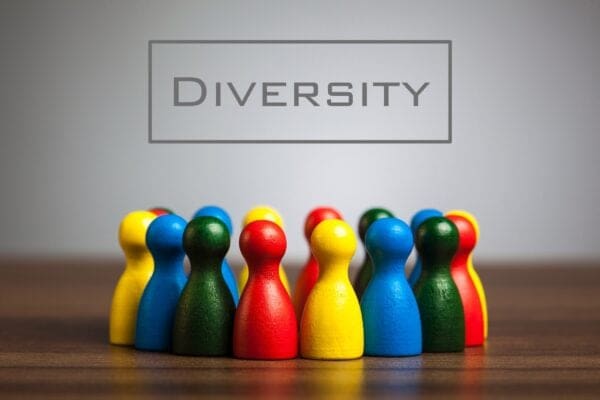It is No Secret That the Workforce is Constantly Evolving
Employees are no longer retiring at 65 or staying with the same company for 40 years. The days of working your way up the ladder are gone, and that is a good thing! With such a diverse pool of talent to choose from, businesses can gain a competitive advantage by implementing a multigenerational workforce.
As our workforce becomes increasingly diverse, it is important to understand the benefits of having an intergenerational workplace. An intergenerational workforce is defined as a workplace that includes employees of different age groups. This includes the 4 main generations of employees at work, which consist of baby boomers, Generation Xers, millennials, and even members of Generation Z.
Organisations with a multigenerational workforce can enjoy more effective communication. That is because employees of different ages tend to communicate in different ways. For example, younger workers are more likely to communicate via text or social media, while older workers may prefer face-to-face conversation or email. By having a mix of ages in the workplace, organisations can tap into different communication styles and get their message across more effectively.

The Challenges
Managing an intergenerational workforce also has its challenges. One of the biggest multigenerational workforce challenges is managing different work-life balance expectations. For example, younger workers may value work-life balance more than their older counterparts. As a result, they may be more likely to take advantage of flexible work arrangements like telecommuting or compressed workweeks.
Intergenerational diversity in the workplace also results in a more diverse pool of ideas. That is because employees of different ages tend to have different perspectives on things like work processes, customer service, and product development. By tapping into this multigenerational diversity of thought, organizations can develop more innovative and effective solutions to business challenges.
In today’s business world, the ability to manage a multigenerational workforce is a critical skill for any manager. By understanding the benefits and intergenerational workforce challenges, you will be better equipped to build a high-performing team that can take your business to the next level.

What is a Multigenerational Workforce?
A multigenerational workforce is a workplace that includes employees of different age groups. This can include baby boomers, Generation Xers, millennials, and Generation Z. Having an intergenerational workforce can bring many benefits to an organization, including more effective communication and a wider range of skills and experience.
There are many advantages of having a multigenerational workforce. One advantage is that it can lead to more effective communication. This happened because employees of different ages groups communicate differently. The younger workers would prefer to communicate via text or social media, while older employees may opt for face-to-face conversation or even emails. By having different age groups in the workplace, companies can tap into various communication styles to get their message across more effectively.
Another advantage of having an intergenerational workforce is that it can provide a wider range of skills and experience. Employees of different ages often have different skills and experiences to offer. For example, younger workers may be more familiar with new technologies, while older workers may have more expertise in traditional methods. By mixing different age groups in the workplace, organizations can benefit from a wider range of skills and experience.
There are many other advantages of having a multigenerational workforce, such as increased creativity, greater understanding of customer needs, and more.
Here are 5 major advantages of having an intergenerational workplace:
1. Increased Creativity and Innovation
To meet the ever-changing needs of the marketplace, businesses must be creative and innovative. One way to encourage creativity and innovation is to have a multigenerational workforce. When employees of different ages work together, they bring a variety of perspectives and experiences to the table. This can lead to new and innovative solutions to problems. In addition, an intergenerational workforce can help to create a culture of innovation within an organisation. When employees feel that they can share their ideas freely, they are more likely to be creative and innovative. As a result, businesses that embrace a multigenerational workforce are more likely to be successful in today’s ever-changing marketplace.

One advantage of having a multigenerational workforce is that it can lead to increased creativity and innovation. That is because employees of different ages tend to have different perspectives on things like work processes, product development, customer service, etc. By tapping into these diverse perspectives, companies can create more effective solutions.
In today’s increasingly competitive business environment, the ability to innovate and create new things is more important than ever. By harnessing the power of a multigenerational workforce, organizations can boost their creativity and Innovation levels, giving them a competitive edge.
Sticky Learning ® is 7 times more effective than 1-day training courses. Plus, you will get a Chain of Evidence proving your Return on Investment. Discover soft skills training that changes behaviours long term.

2. More Effective Communication
The workplace is more diverse than ever before, with people of all ages and backgrounds working side-by-side. This can be a great opportunity to learn from each other and improve communication across the generations.
One of the key advantages of having an intergenerational workforce is that it can lead to more effective communication. Different generations have different communication styles, and by understanding and respecting these differences, we can bridge the gap and improve understanding between co-workers. Such a cohesive working environment would prove beneficial in enhancing the productivity of the company immensely. It also has the potential to come up with modern innovations for improving the product and services.
3. Greater Flexibility and Adaptability
A multigenerational workforce can also be more flexible and adaptable. That is because employees of different ages tend to have different skillsets. For example, younger workers may be more tech-savvy and able to adapt to new technologies quickly, while older workers may have more experience and institutional knowledge. By having a mix of ages in the workplace, organizations can be more flexible and adaptable to change.
Different generations in the workforce also help to create a more diverse range of perspectives, which can lead to new and innovative solutions. Such solutions may not have been possible with a workforce made up of employees from just one generation. Hence, it is always a good idea to have employees of different generations working together in an organization.
4. Better Problem-Solving Skills
Another key advantage is that a multigenerational workforce can lead to improved problem-solving. With a mix of ages and backgrounds, employees can bring different perspectives to bear on solving workplace issues. This can lead to more innovative and effective solutions.
Furthermore, a multigenerational workforce is that it can help to build a more well-rounded team. With employees of different ages, you can tap into a wider range of skills and knowledge. This can make your team more versatile and better able to meet the challenges of the workplace.

A multigenerational workforce can also bring a sense of mentorship and knowledge-sharing to the workplace. Younger workers can learn from the experience of older workers and vice versa. This can help to create a more collaborative and supportive work environment.
Finally, a multigenerational workforce can help to create a more dynamic workplace. With employees of different ages and backgrounds, there is the potential for a greater exchange of ideas and a more vibrant work culture.
5. Increased Productivity and Profitability
One key advantage of an intergenerational workplace is that it can lead to increased productivity and profitability. With workers of mixed ages and backgrounds, the employees can bring different viewpoints to work on workplace issues.
A multigenerational workforce can also create a more dynamic workplace. There is the potential for a greater exchange of ideas with employees of different ages and backgrounds. All these factors can lead to increased productivity and profitability for your business.
Effectively Leading a Multigenerational Workforce
To effectively lead a multigenerational workforce, it is important to understand the unique strengths and challenges of a multigenerational workforce, that come with managing employees of different ages.
For example, younger workers may need more guidance and structure, while older workers may prefer more independence. Additionally, different generations may have different motivations. For example, younger workers may be more interested in career growth, while older workers may place more value on work-life balance.
By understanding these differences, leaders can more effectively manage and motivate their employees. Additionally, leaders should provide opportunities for intergenerational collaboration, such as mentorship programs.

Below, we have provided some of the best practices for managing a multigenerational workforce:
Develop a Robust Employee Value Proposition
If you want to attract and retain the best talent, you need to have a robust employee value proposition (EVP). Your EVP is what makes your company an attractive place to work and sets you apart from your competitors. It should be based on your company’s unique culture, values, and mission.
Some things to consider when developing your EVP:
- Your company’s core values.
- Your unique organisational culture
- Opportunities for career development.
- Your work/life balance.
- Benefits and rewards.
Your EVP should be attractive to a wide range of employees, from entry-level to senior executives. It should be something that speaks to your company’s unique identity and what makes it a great place to work. If you are not sure where to start, ask your employees what they love about working for your company. Their feedback will be invaluable in developing an EVP that works for your business.
Modify your Hiring Process to be Inclusive

If you want to attract and retain top talent from all generations, you need to have an inclusive hiring process. This starts with your job postings. Make sure your job descriptions are clear, concise, and free of any jargon or buzzwords that could turn off potential candidates.
Next, you need to ensure that your application and interview process are accessible to everyone. This means providing clear instructions and making accommodations for different types of learners. For example, you might provide a written version of your application as well as a video or audio recording.
Adopt Diverse Communication Styles
If you want to appeal to multiple generations, you need to adopt diverse communication styles. This means using a variety of channels to reach your audience. For example, you might use email to communicate with baby boomers, text messaging to reach millennials, and social media to connect with Generation Z.
It is also important to use language that is appropriate for each generation. Baby boomers tend to prefer formal language, while millennials and Generation Z are more likely to respond to slang and emojis.
Enable Smoother Feedback Collection
If you want to collect feedback from all employees, you need to enable smoother feedback collection with a multigenerational workforce. This means using a variety of channels to reach your employees.
By using a variety of communication channels and styles, you can make sure that you are reaching all employees. This will help you collect more accurate feedback from the different generations.
Accommodate Flexible Working Arrangements
If you want to accommodate the needs of all generations, you need to make flexible work arrangements. This means offering different types of schedules, telecommuting options, and leave policies.
For example, you might offer flexible schedules to employees who need to care for young children or ageing parents. You might also offer telecommuting options to employees who live in rural areas or have long commutes. And you might offer extended leave policies for employees who need to take care of a sick family member.

Avoid Stereotypes
When you are working with a multigenerational workforce, it is important to avoid stereotypes. This means not making assumptions about people based on their age. For example, you might assume that baby boomers are resistant to change or that millennials are entitled.
These assumptions can lead to bias in the workplace. If you are biased against someone, you are less likely to treat them fairly. This can result in discrimination and exclusion.
To avoid bias, it is important to get to know each employee as an individual. This way, you can see them for who they are, not for their age. By doing this, you can create a more diverse and inclusive workplace.
Conclusion
As evident by this article, there are many advantages to having a multigenerational workforce in the workplace. A multigenerational workforce can lead to improved problem-solving, increased productivity and profitability. As well as, a more well-rounded team, a sense of mentorship and knowledge-sharing, and a more dynamic workplace. If you are looking to build a thriving business, tapping into the power of a multigenerational workforce is a great place to start.
There are many advantages to having a multigenerational workforce in your workplace. For one, different generations bring different perspectives and skillsets to the table. This can make for a more well-rounded and innovative workplace.
Intergenerational workplaces can also be more flexible since different generations tend to have different work/life balance needs. This can make it easier to accommodate employees with different schedules and responsibilities outside of work.
Additionally, a multigenerational workforce can provide a support network for employees of all ages. Different generations can learn from and lean on each other, making for a more cohesive and supportive workplace.
Finally, a multigenerational workforce can reflect the community your business is a part of. Having employees from different backgrounds and social classes can make your business more relatable and approachable to potential customers.




